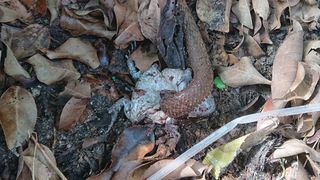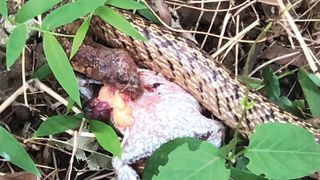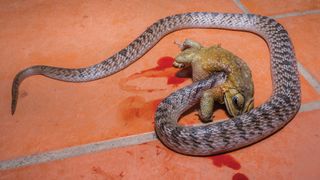Snakes insert their heads into living frogs' bodies to swallow their organs (because nature is horrifying)
The encounters left frogs absolutely gutted.

For knife-toothed kukri snakes, the tastiest parts of a frog are its organs, preferably sliced out of the body cavity and eaten while the frog is still alive. After observing this grisly habit for the first time in Thailand, scientists have spotted two more kukri snake species that feast on the organs of living frogs and toads.
The new (and gory) observations suggested that this behavior is more widespread in this snake group than expected. Two snakes also eventually swallowed their prey whole, raising new questions about why they would extract the living animals' organs first.
The scientists documented a Taiwanese kukri snake (Oligodon formosanus) and an ocellated kukri snake (Oligodon ocellatus) pursuing amphibian organ meals, tearing open frogs' and toads' abdomens and burying their heads inside, according to the studies. O. formosanus would even perform "death rolls" while clutching its prey, perhaps to shake the organs loose. As the snakes swallowed the organs one by one, the amphibians were still alive. Sometimes, the process would take hours, the researchers reported.
Related: Beastly feasts: Amazing photos of animals and their prey
There are 83 species of kukri snakes in the Oligodon genus in Asia. The snakes typically measure no more than 3 feet (100 centimeters) long, and the group's name comes from the kukri, a curved machete from Nepal, as its shape is reminiscent of the snakes' large, highly modified rear teeth. Kukri snakes use these teeth for slicing into eggs, but they can also be formidable slashing weapons (as some very unfortunate frogs have discovered).
In one study, published Feb. 15 in the journal Herpetozoa, scientists described three snake attacks on rotund banded bullfrogs (Kaloula pulchra), which are so round that they are also known as bubble frogs or chubby frogs. They have brown backs with lighter stripes down their sides and cream-colored stomachs, and they measure up to 3 inches (8 cm) long, according to Thai National Parks.
Two of the attacks were by Taiwanese kukri snakes, and took place in Hong Kong in October 2020. One snake, filmed on Oct. 2 in a residential neighborhood garden, emerged from a hole in the ground to bite a passing bubble frog, slicing open the frog and stuffing its head inside. Snake and frog tussled for about 40 minutes; the snake performed about 15 body rotations, or "death rolls," during the battle, according to the study.
Sign up for the Live Science daily newsletter now
Get the world’s most fascinating discoveries delivered straight to your inbox.
"We believe that the purpose of these death rolls was to tear out organs to be subsequently swallowed," Henrik Bringsøe, lead author of both studies and an amateur herpetologist and naturalist, said in a statement.

A second Taiwanese kukri snake was discovered on Oct. 8 in an urban park while "energetically" dining on a frog's organs that were "exposed and visible," the study authors wrote.
The third attack on a bubble frog was by a small-banded kukri snake — the species that was first documented exhibiting this behavior — on Sept. 15, at a factory site outside a small village in northeastern Thailand. During the struggle, the snake performed 11 death rolls, its teeth buried firmly in the frog's belly.
"The snake’s efforts resulted in its teeth penetrating the abdomen to such an extent that blood and possibly some organ tissue appeared," the scientists reported. "Eventually, the frog was swallowed whole while still alive."
Another study, published on the same day in Herpetozoa, presented an observation of an ocellated kukri snake feasting on an Asian common toad (Duttaphrynus melanostictus) inside a lodge in a national park in southern Vietnam. These toads are stout, thick-skinned and variably colored, and they measure about 3 inches (8.5 cm) long, according to Animal Diversity Web, a biodiversity database maintained by the University of Michigan's Museum of Zoology.
Observers recorded this attack on May 31, 2020. The toad was already dead at the time, "and the snake was moving its head and neck side to side as if trying to work its way inside," the study authors wrote. Minutes later, the snake gulped down the toad whole.

In the 2020 study about small-banded kukri snakes eviscerating Asian common toads, the scientists hypothesized that the snakes selectively ate the organs to avoid the toads' deadly toxins. However, the ocellated kukri snake swallowed the toad after its organ appetizer, hinting that the snakes might have some natural resistance to the toads' poison.
Chubby frogs also have a built-in deterrent that may encourage predators to go straight for their organs. While the frogs aren't toxic, they defensively secrete a sticky mucous that has an unpleasant taste, according to the University of California, Berkeley's AmphibiaWeb.
"We hope that future observations may uncover additional aspects of the fascinating feeding habits of kukri snakes — though we may indeed call them gruesome!" Bringsøe said in the statement.
Originally published on Live Science.

Mindy Weisberger is an editor at Scholastic and a former Live Science channel editor and senior writer. She has reported on general science, covering climate change, paleontology, biology, and space. Mindy studied film at Columbia University; prior to Live Science she produced, wrote and directed media for the American Museum of Natural History in New York City. Her videos about dinosaurs, astrophysics, biodiversity and evolution appear in museums and science centers worldwide, earning awards such as the CINE Golden Eagle and the Communicator Award of Excellence. Her writing has also appeared in Scientific American, The Washington Post and How It Works Magazine.
